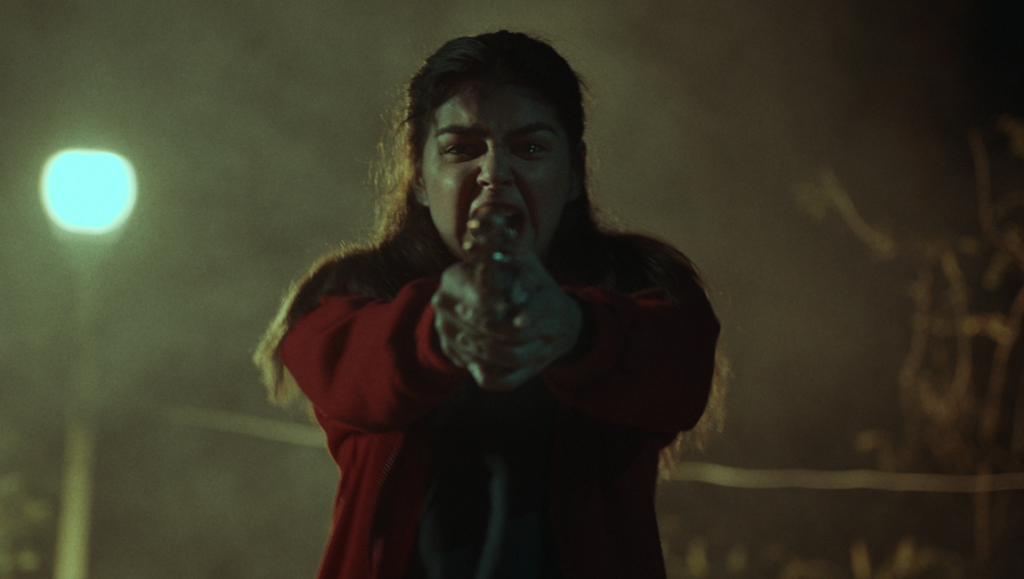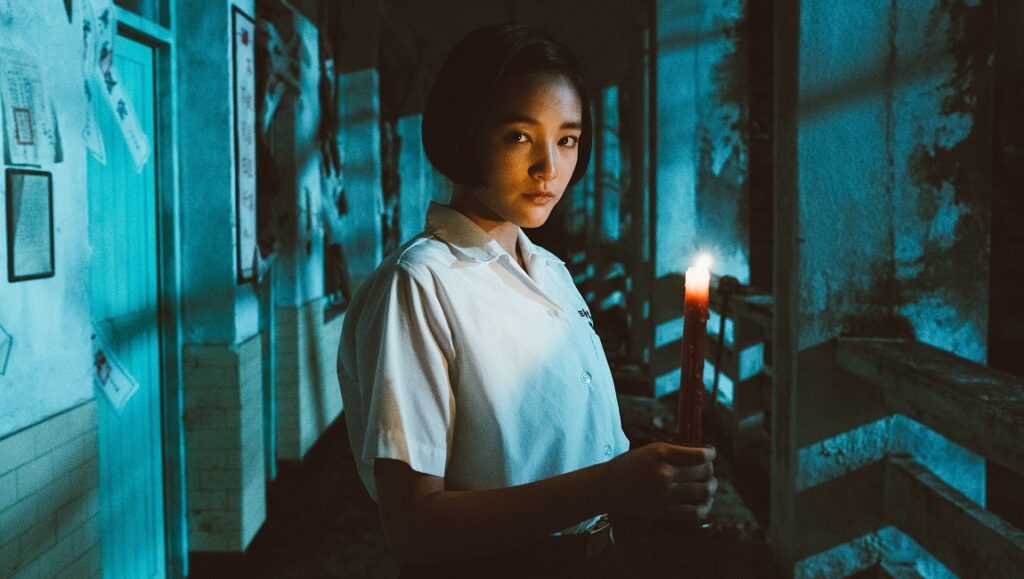Soul
Emir Ezwan’s debut feature, Soul, is part of an emerging Malaysian cinema heavily composed of genre fare. Made for roughly $80,000 USD, the horror film is clearly a labor of love and, on the strength of its slick jungle compositions and dark, dynamic vistas, would seem to easily transcend its budgetary constraints. Unfortunately, that’s where the praise ends, as Soul otherwise relies on generic mimicry of the formula and imagery of better horror efforts. Seemingly every other shot here is a slow, ominous push-in artlessly used to signal an encroaching unseen something, and nearly every cut is preceded by doomy musical swells — the latter rendered more comical than sinister given the film’s short scene durations. In one instance, a local myth is vaguely, bafflingly recounted; the scene is presumably meant to provide some narrative context, but becomes entirely unwatchable thanks to its hilariously tone-deaf musical punctuations. Elsewhere, Ezwan is content to cycle through a litany of familiar horror imagery: shadowy background figures that casually pop up across the runtime, decrepit bodies speedily crawling like spiders as in J-horror, and a generically mysterious, imposing stranger who carries a spear and is blind in one eye (because of course he is). A menagerie of birds are slaughtered (and sometimes eaten raw, for no discernible purpose), and some ill-defined witchy ritualism makes an appearance courtesy of another stranger, she of the kooky-spooky variety. By the time the film’s eco-horror inclinations are made evident, replete with some anti-transcendentalist leanings and a kind of earth witch delivering an expository monologue detailing the impenetrable and deeply silly nonsense of the previous 80 minutes, it hardly matters — early-aughts Shyamalan couldn’t have saved this. Ezwan would do well to take a closer look at the films he so clearly admires. Luke Gorham

The Girl and the Gun
Godard’s famous axiom (by way of D.W. Griffith) about a girl and a gun being the essential elements of a movie is given a very literal demonstration in Rae Red‘s grim and despairing solo directorial debut The Girl and the Gun. The narrative is neatly bisected into two distinct halves, and the transition is fittingly situated at almost the exact midpoint. The first half follows a young woman, the unnamed girl of the title (Janine Gutierrez), a downtrodden, constantly put-upon sad-sack anxiously navigating the mean streets of Quezon City, Philippines. The meager wages she earns as a department store saleswoman barely cover her rent and the funds she sends to her family in the provinces. She’s mostly isolated at her job, since she can ill afford to go out drinking with her coworkers after work. Her boss often insults her appearance, threatening to fire her for wearing torn stockings. She must endure sexual harassment from male customers, as well as catcalling from guys on the street on her way home from work. Her roommate has a violently abusive boyfriend who threatens the Girl to prevent her from intervening or telling anyone else about his abuse. When this succession of indignities culminates in her suffering a sexual assault, she gets her hands on a gun found in the street, setting out to right the many wrongs perpetrated against her. The film then rewinds itself and follows the gun, from its manufacture and assembly, to its use in Marcos-era extra-judicial killings, to its significance to a little boy in the 1980s who grows up to be a police officer in the present day, a foot soldier in Rodrigo Duterte’s brutal and singularly inhumane war on drugs.
Red’s film has a runtime of a mere 80 minutes, yet she ambitiously tackles a great many subjects as she laments the social and political ills of her home country: the patriarchal nature of a society that openly oppresses women; the chasm of class divisions plaguing the Philippines; the indiscriminate and unjust rounding up of suspects in Duterte’s drug war. These admirable aims are marred by Red’s muddled messaging. The conclusion appears to take an anti-gun stance, and the film often laments the violence permeating the street life Red so vividly captures. Yet the gun is the means by which the Girl is able to regain some measure of control over the oppression which has so constricted her. As such, we are left with an unsettled line blurring between glorifying and decrying the power that the gun gifts to the person holding it in her hands. Christopher Bourne
Miyamoto
Miyamoto hopes to manifest the power of a pendulum hanging over one’s head — swaying, seeking a point of equilibrium. That pendulum is morality: At the core of director Tetsuya Mariko’s adaptation (there’s already been a Miyamoto manga and TV series) is a rape, but from this act arises an attempt to qualify a reactionary effect rooted in patriarchal gazes [??]. In the film, Miyamoto (Sosuke Ikematsu) drunkenly rages through a series of fetishized toxic displays after his partner, Yasuko (a wholly determined Yū Aoi), is raped. The rape itself becomes an act that Miyamoto takes as a personal attack — an emasculation that can only properly be righted through performative, self-aggrandizing physicality. Which is to say that the core of this film is actually a man’s ego. Mariko furthers this impression through the way he aestheticizes the scenes of Miyamoto being violent, leaving us with a film that’s formal ‘gaze’ is essentially of-a-piece with the patriarchal perspective it seems to be trying to critique. We see this in the rape scene as well: Mariko cuts constantly between a blacked-out Miyamoto and a pinned-down Yasuko — as if their experiences justified parallel representation. Miyamoto’s agency is already being established here, through the inability to defend Yasuko becoming an equally (if not more so) weighted event of trauma to Yasuko’s rape.
Problematic as that set-up is, I feel that it’s worth reflecting on the lack of disgust I felt while watching Miyamoto’s vengeance play-out on screen; when, at one point, a predator is castrated, I indeed felt a charge of satisfaction toward the act. It becomes clear, also, that Mariko means to exploit that emotion, particularly as bred by toxic masculinity. One way that this is conveyed is through the utter futility of Miyamoto’s violence, which serves as tacit recognition of the immorality of the form of entitlement that’s being exercised through his acts. Miyamoto finally leaves its central couple at a point of agreeable resolution for their relationship, which recalls a sentiment that’s expressed at the beginning of the film: “the balance between happiness and unhappiness is remarkable.” Mariko is clearly attempting to find this balance — to swing the pendulum in the right direction at the right time, ruminating on the implications of objectified and reappropriated trauma while also suggesting that a certain kind of ‘romanticism’ can be arrived at by following a messy path to redemption. But this film never reconciles the convolution of those twinned stances, and as such it never convincingly gets inside its own trauma. Zachary Goldkind
Detention
John Hsu’s debut feature Detention isn’t so much a horror film with political undertones as it is a historical, political drama with brief flashes of horror imagery. Unfortunately, it fails to station itself effectively in either of its ostensible genre territories. Set in Taiwan during the 1960s, at the height of fascistic martial law, the film’s present-tense plot begins with two high school students waking up to find themselves trapped in their vacated campus. Flashbacks reveal that the protagonist Fang Ray-Shin (Gingle Wang) acted as a whistleblower against a secret leftist book club she attended, leading to the government-mandated torture and execution of several peers and teachers. Much of the film focuses on this past timeline, which also tells of a star-crossed love affair between Fang and her teacher Chang Ming-Hui (Meng-Po Fu). Through sophisticated framing, lighting, and production details, Hsu demonstrates a commendable visual aptitude, which is clearest when the film unfolds in the present tense. However, the knotted story places much of its emphasis on flashbacks, which become mired in tiresomely didactic dramatic conventions.
Also unfortunate is the film’s engagement with horror imagery: rather than capitalize on the genre’s potential for allegory or symbolic heft, Detention crudely grafts its horror iconography directly onto its story and offers very little beyond literalized expressions of already-present threats. The film’s spectral figures (beautifully animated, cadaverous, uniformed government officials) are simply stand-ins for known evils from the flashback timeline: fascist surveillance in the White Terror era of martial law. When it comes to horror, the film shows its hand too early and too carelessly. Its spooky moments are mostly compelling, especially in the first act, but the genre elements quickly feel weightless and out of place, deflated of allegorical potential. When it comes to political drama, the narrative is broad and manipulative, resulting in a rather standard, unsubtle historical piece with arbitrary and unsatisfying invocations of the supernatural. Director Hsu shows great potential, especially for a first-time filmmaker, and the film includes some striking images, but its cumulative effect leaves much to be desired. Mike Thorn
— [Originally published as part of InRO’s 2020 Fantasia Fest coverage.]



Comments are closed.